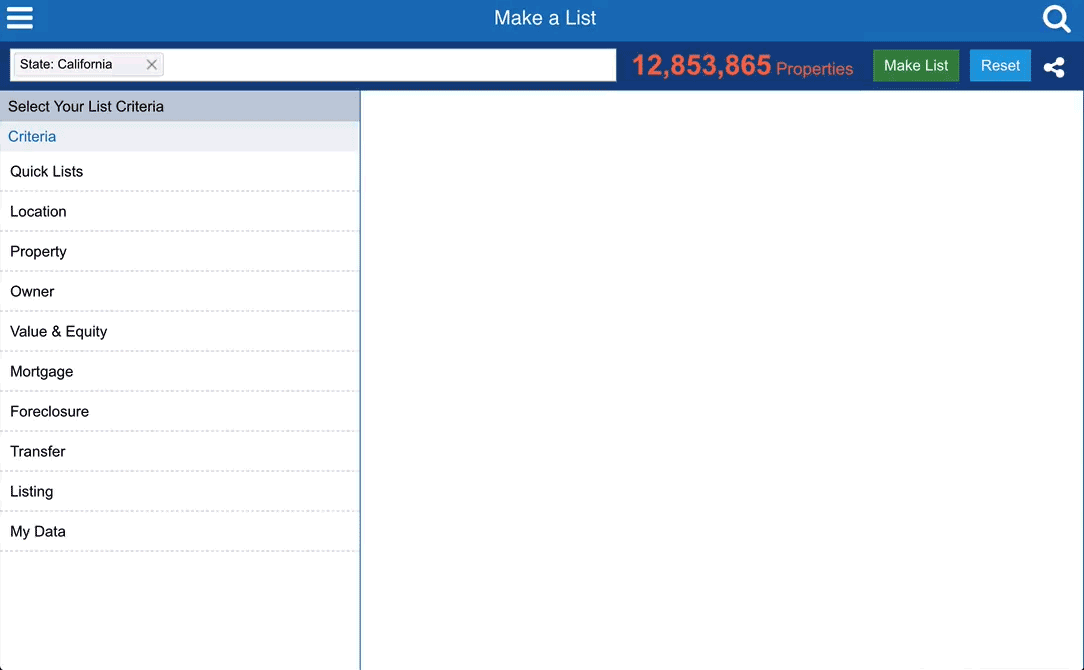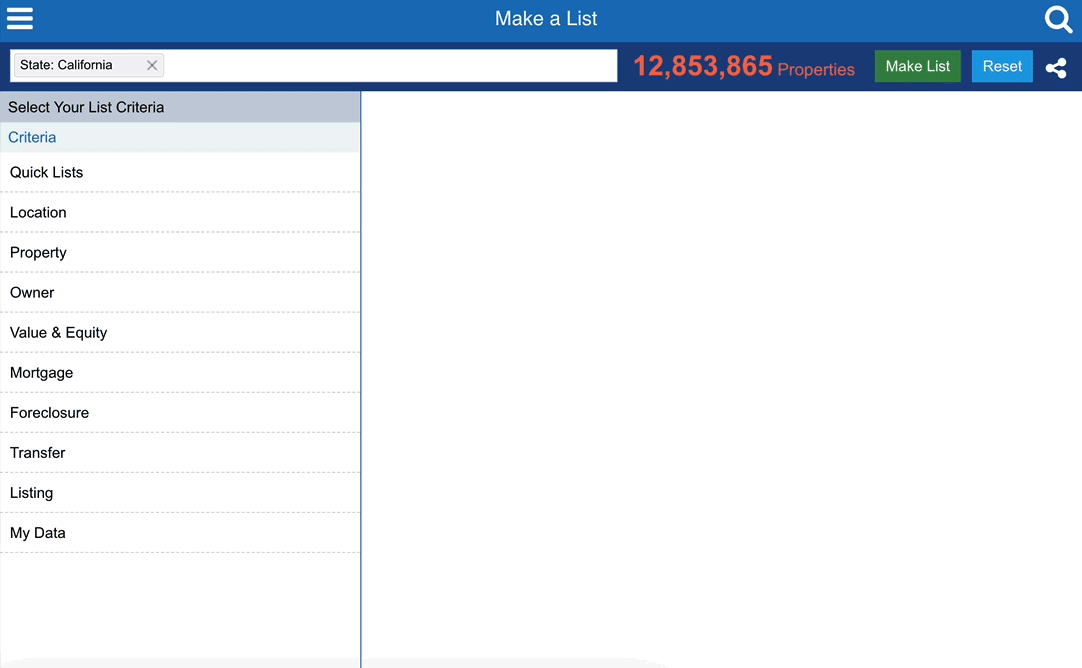How to Find and Generate Leads on Vacant Properties

Lock Down Your Next Vacant Home Lead With Our Comp32ete Guide
As real estate investors, we know vacant properties can have the potential to be great deals.
There’s typically clear seller motivation to offload the property, and depending on the current condition, you can occasionally get the residence for less than market value – which could mean a lot more money left in your pocket.

While finding these properties may initially seem easy, there are often many more homes available to you than just those with overgrown front yards and overflowing mailboxes.
You just have to look a little harder.
According to a recent report from the US Census Bureau, over 10% of all housing units in the United States were vacant in 2023's Q4. While that number may sound small, in actuality, that equates to over 14.7 Million properties.
That’s a whole lot of opportunity waiting, especially during a time in the market where high mortgage rates and low traditional inventory make snagging sales an uphill climb.
So, how can you get in the game and track down the vacant properties in your area?
There’s no time like the present to hitch your wagon to this stream of cash flow, and the longer you wait before diving in, the more competition vacant properties will face.
So read on for our top three strategies to help you expand your property business and get you scooping up vacant homes like the pro you are.
In this complete guide, we'll cover:
-
What Are Vacant Properties?
-
How To Find Vacant Properties In Your Community
- 6 Questions To Ask When Building A Vacant Property List
-
Making Your Move And Reaching Homeowners
What Exactly Are Vacant Properties?
Abandon your preconceived notions of empty shacks in barren fields wobbling with the wind.
Vacant properties indicate homes where mail is no longer deliverable. This may indicate that the home is not occupied by either an owner or tenant. This often suggests that the owner may either want (or need) to sell the property.
However, it's not as simple as it sounds. There are a few vital nuances you want to keep in mind as you investigate potentially vacant residences.
The US Postal Service's vacancy data outlines:
1. Whether or not a property is identified vacant, or
2. Whether or not an owner's mailing address is identified vacant.
An owner's mailing address may be different from the property address you are investigating, mainly due to the fact that the owner may primarily live elsewhere while still owning that property you spotted.
The USPS offers this data in order to help you avoid sending mail to addresses which are not deliverable, and addresses where no one is actively picking up mail.
Therefore, you want to leverage this information wisely for your lead generation. At the end of the day, you want to ensure you're not wasting postage and that you're being deliberate around the destination of your contact efforts. You want to reach the owner, after all!
Certain properties may be classified as vacant even when they aren't exactly what you would imagine as "vacant." These homes may instead be seasonal properties (aka vacation homes), rentals, or are undergoing renovation.
And with this, not all vacant property owners will be interested in selling.
However, many may be.
For example, homeowners who have recently inherited problem properties in need of serious repair may be disinterested in the time and effort renovations may take. They may be looking to offload the home and make a quick profit.
Rental property owners may grow tired of the residence management and upkeep of a secondary home and simply want to sell and be done with it.

Vacation homeowners may want to liquidate seasonal properties to invest back into their savings. Homes may be facing foreclosure, repossession, or have sustained significant damage.
There are many possibilities as to why exactly a home may be sitting unoccupied. And while some may be more obvious than others, we’re here to help guide you through how to find all of these properties in order to make a serious profit and help the homeowners who truly need it.
How To Find Vacant Properties In Your Community – 3 Strategies
Driving For Dollars
Driving for dollars is one of the oldest real estate methods in the book – and one of the most reliable.
Not familiar?
Driving for dollars describes traveling through nearby communities and capturing information in real-time on houses you spot from the road.
.jpg?width=2047&height=1136&name=iStock-1302900609%20(1).jpg)
A productive use of field marketing, this allows you to better understand a specific property based on its neighborhood and overall appearance. It’s a great way to collect a list of homes that may be vacant, distressed, or ready to go on the market.
While you may argue this approach could be timely (and, with the price of gas these days, costly) – just remember that many of the official vacant home listings you may have access to through MLS, other realtors, and investors have access to as well.
If you want a leg up on the competition, getting out there and burning rubber on your own may just be the best way to do it. You could be the first to spot an estate sale, a newly vacated residence, or a home in a fresh state of disrepair. This immediately allows you an “in” over competitors and a head start on a home sale.
Wondering how to start?
- Research surrounding neighborhoods of distress and plan your routes. While your driving doesn’t need to be restricted here, you’ll find more vacant and distressed properties by intentionally targeting neighborhoods you know have a higher concentration of these types of residences.
- Know how to spot signs of vacancy. Tell-tale signs of vacant properties include:
-
Overgrown, neglected, and unkempt landscaping
-
Boarded up windows
-
Overflowing mailbox, unattended mail, packages, or newspapers
-
Broken windows, doors, or clearly damaged exterior (think driveways, roofs, etc.)
-
Any code enforcement tape, posters, or government notice
-
Absence of cars and tire tracks
-
No curtains in the windows
-
-
Document your findings. Don’t let all that hard work go to waste. Whether with pen and paper or leveraging a property tracking app, make sure to capture the vacant houses that catch your eye. You don’t need to do your deep dive research on the spot to confirm if these properties are indeed vacant, but you want to drive away with a strong list of potential leads, and this ensures that gets done.
-
Follow up with owners. Once your list is complete, research your properties against public records data to understand if the house is vacant and who the homeowners may be. Once you have that information, reach out to inquire about their interest in selling. Pro-Tip: Even if the home is not vacant (remember, these may be seasonal or rental properties), that doesn’t mean your outreach won’t be appreciated. Active homeowners or property managers may be underwater or tired of the responsibility of house upkeep, and your contact may be the push they need to sell
Tapping Into Public Records Data With Lead Gen Software
Public records are filled with vital information on vacant properties. Look up foreclosures, preforeclosures, evictions, and more.
The bad part? Digging through public records can be a huge time and energy drain, and you’ll have to search individual property by individual property – which is simply a colossal ask if you’re seeking answers on multiple homes.
A better way? Leverage lead generation software, which effortlessly taps into public records, displaying them in a user-friendly, easily accessible format – often over desktop or mobile apps.

Quickly gain extensive information on any specific property or search hyperlocal radiuses to better understand entire neighborhoods and the vacant properties potentially housed within.
You can also maximize your time and effort by building personalized lists of potentially vacant properties within your community. That way, you can track and target the specific properties (and homeowners) you’re looking for, all while being personalized and specific in your messaging.
Leveraging Direct Mail Campaigns
Direct mail campaigns are a generally great marketing tool for real estate investors. You can usually leverage them to be hyper-personalized and specific with custom offers toward singular residences or send to larger subsets of homes in your hyperlocal community.
Direct mail is physical marketing sent through traditional postal mail. That’s right – it’s advertising sent straight to your mailbox. While it may sound old-fashioned, the results are anything but.

Even in today’s digital age, direct mail has a much higher response rate than email marketing. Another perk? Data shows that 80-90% of direct mail gets opened, compared to only 20-30% of email.
Normally, this is an approach that bypasses digital barricades and gives your marketing another chance to get in the hands of property owners.
However, you cannot target vacant properties – remember, mail is no longer deliverable – but you can add “Return Service Requested” to each piece of mail within your campaigns.
Why is this useful?
While vacant properties do not have anyone picking up their mail, adding the above phrase may occasionally bring you a variety of positive outcomes. This includes the forwarding of your direct mail to the homeowner’s new address (in the case that the owner's mailing address is not listed as vacant) or mail returned to you with a handy yellow sticker from the USPS that not only confirms if a property is truly vacant, but it also outlines the property owner’s new address.
This tactic is ideal for homes that are unoccupied but not formally vacant.
To break it down, these homes may be seasonal vacation properties or rental residences where the owner (the landlord of the property) does not live onsite. Because you want to target the homeowner vs the tenant, this can help you get one step closer to that homeowner's mailing address - and closer to a potential sale.
Bingo. Let outreach commence.
6 Questions To Ask When Building A Vacant Property List
1. Is it owner-occupied or non-owner-occupied?
When setting out to find vacant properties, the first, and arguably most important, thing to understand is if the vacant homes are owner-occupied or non-owner-occupied. Depending on the status, it will drastically change how you market.
When determining the status of homes on your vacant property list, there are two sources you can use to find vacant houses: the County Assessor and the US Postal Service.
The US Postal Service's vacancy data outlines:
1. Whether or not a property is identified vacant, or
2. Whether or not an owner's mailing address is identified vacant.
So, for example, you may run into a situation where the County Assessor will keep a property marked as owner-occupied because they mailed a tax bill to the address. However, the US Postal Service may classify the property differently if no one is picking up the mail.
In this example, if the property is owner-occupied and vacant, you have to take additional steps to track down that owner further because you can’t rely on the physical address alone.
So remember, when you find vacant houses, you may need to do more research.
In most cases, you’ll have to skip trace to find vacant property owners and their contact information. However, most investors won’t put in the time to do this, so you’re more likely to encounter less competition if you take the extra time.
Additionally, you’ll want to determine whether or not the homes on your list have an Absentee Owner.
Absentee owners are individuals who own a property but don’t live in it as their primary residence.
Why do people become absentee owners? They may be acquiring extra income through rental properties or have secondary residences that serve as vacation homes.
And why do these homes get marked as vacant?
This happens for a few reasons. First, one of their rental properties or one of their vacation homes, given it’s infrequently lived in, could be marked as vacant. If it’s a rental property, maybe they're in between tenants, doing a renovation, or maybe they just evicted somebody.
However, timing may be important here. If they’re an absentee owner going through any of those situations, there’s a chance they may be rethinking ownership. Believe us- it’s more common than you may think! Dealing with a rental property is a ton of work, and evicting a tenant can be even worse.
In short, doing the work to determine if your list has properties that are owner-occupied or non-owner-occupied is crucial to determine and build your strategy around.
2. What kind of vacant property characteristics are you targeting?
As with any list you build as a real estate investor, you’ll need to determine the property criteria you’re looking to target.
So do you want a single-family property? Do you want a condo property? Make sure you review your strategy to develop a vacant properties list around your ideal number of beds, baths, and square footage.
It may sound straightforward, but applying property characteristic criteria to your search will ensure you're marketing to the vacant houses you want to invest in.
Some examples of property characteristics include:
- Number of bedrooms
- Number of bathrooms
- Square footage
- Year built
- Lot Size
- Neighborhood
- Sales price
By narrowing down your vacant properties search based on specific property criteria, you’ll be able to find vacant property leads fitting your investment strategy and generate personalized messaging in your outreach.
3. Are you marketing to the value you’re willing to spend?
Often, investors can get caught up in a property being marked as “vacant” and fail to look into other determining factors before adding it to marketing outreach. If you’re finalizing your list of properties, ensure to consider the estimated value.
When finding vacant properties, it can be tempting to include as many properties as possible to make your list as big as possible, but it’s just not realistic.
For example, if a real estate investor has a target budget of $1,000,000, but includes all vacant houses in a single list, they may risk reaching out to the owner of a $10,000,000 property.
We’re big proponents of marketing smarter, not harder, so if you’re wasting your budget on marketing property owners whose homes are far above your target budget, you may want to reconsider the list you’ve built. Again, this may sound simple, but it will save you big in the long run.
4. How long has the vacant property been owned for?
When building a vacant property search, ownership length is the next thing to consider. It’s a crucial detail that often can determine whether or not you market to a specific vacant property.
Let’s think about it this way. If someone bought a property two months ago and it’s been marked as vacant, it’s most likely because the new property owners haven’t moved in yet, or are renovating it.
With vacant properties, it’s critical to look beyond face value and do some digging to understand the circumstances better.
In general, targeting a vacant house list of homes owned for at least three years or longer is ideal. Why? Because, that way, you’re out of the “flip window”. The flip window is the time frame an investor will most likely undertake renovations on their newly acquired property.
Typically, most flips occur in less than 12 months, but’s common to see them as far out as 24 months as well. Therefore, setting your ownership length to no less than 36 months should keep you in the clear.
In fact, taking that a step further, one of the most popular vacant property lists investors like to use is non-owner-occupied vacant properties that have over 10 years of ownership. Often you’ll find landlords who have owned properties for a long time and are facing owning a vacant property that isn’t generating them any income. At this stage, they're likely looking to get out of owning the property and the burdens that come along with it.
5. What other investment criteria are you targeting?
While a major motivating factor, vacancy isn’t the only reason a property owner would look to sell. To find the most motivated sellers, consider adding additional investment criteria to your vacant property list.
By adding additional criteria, also known as List Stacking, you’ll be able to maximize your marketing efforts and connect with owners motivated to sell.
When List Stacking, you can experiment with various criteria to find the best combinations for your strategy. For example, layering in pre foreclosure in with vacancy is a powerful list that combines two motivated seller groups into one.
Additionally, stacking in properties with Liens or combining vacancies with an Underwater list can give you a wide range of potentially motivated sellers.
Whatever combinations work best for you to find vacant properties, the main goal is to use vacancy as a jumping-off point. In doing so you’ll position yourself much better to find better opportunities that close faster and for far below market value.
6. Is the property actually occupied?
While this seems like an obvious question to ask when buying vacant properties, determining if a property is actually occupied can take many forms, most of which don’t work.
Among the most seasoned real estate investors, there’s been a shift toward taking alternative approaches to determine occupancy in seemingly “vacant” properties.
The most common situation where conflicting information causes confusion is when the physical property has a tenant occupying it, but the mailing address of where the tax bill for the property is mailed to has been marked as “vacant”.
In this case, more questions than answers pop up. Chief among them: why would an investor not get their bill mailed to the property?
In this situation, being able to target the mailing address for where the property tax is being mailed is critical. This way, you can connect with the owner to figure out the situation. For example, have they recently moved out of state? Does the county not know the owner doesn’t live there anymore?
Whatever the case, since the owner still is responsible for taking care of the property, it may be more of a burden on them than anything else.
With PropertyRadar, you can see all of this data, giving you the insights you need to find the owner's contact information to reach out to the vacant property owner wherever they may be.
Now That You’ve Found Your Vacant Properties – Make Your Move With PropertyRadar
Now that you’ve got a quality list of vacant properties (and may or may not have the first steps toward finding that prized homeowner contact information), you need confirmation that your outreach is going to the right spot.
What’s a real estate professional to do?
Leverage the power of PropertyRadar to provide you with all of the information you need.

In just a few clicks, you’ll have abundant information on every single vacant property on your list, as well as vacant property owner information that’ll make personalized outreaches a breeze.
In fact, PropertyRadar is the only source in the space that provides both the current vacant home address, as well as the owner's new mailing address.
Suddenly, extensive history on any property is within reach, and you’ll wonder how you ever operated without it.
PropertyRadar helps you search hyperlocally – giving you access beyond what MLS can provide and helping you cut out the middle man (or the extensive searches through public records) by bubbling up the same information in a fraction of the time.
Which means you’re saving valuable time, and your data will be just as accurate.
You can find vacant properties, foreclosures, bank-owned houses, rental residences, and more while most importantly – uncovering homeowners looking to sell.
Better yet? PropertyRadar has the capabilities to allow you to connect with these homeowners in the manner you deem best. Quick phone call? You got it. Email? Definitely. Direct mail? Absolutely. Customize your approach with our technology-first interface and our helpful guides that connect the dots on building lists, automating your workflow, and finding more homes in less time.
If you already have a PropertyRadar account, you can find vacancy data right from Discover.
Criteria > Property > Status > Site Vacant

This will let you know if the property itself has been marked as vacant by the USPS.
Wondering if the owner's mailing address has been marked as vacant?
Criteria > Owner > Mailing Address > Mail Vacant

Not a member yet? Get your free trial now.
Now, you have a direct pathway toward helping offload difficult, distressed, or downright abandoned properties – which also means you’re getting closer to some seriously great deals.
Improving neighborhoods, transforming troubled homes, and walking away with growth in your business? Those all sound like wins to us.
So, what are you waiting for?
Get started now with a free PropertyRadar trial and tap into 150 million properties and 1 billion prospective client phones and emails.



